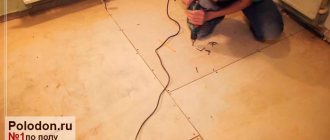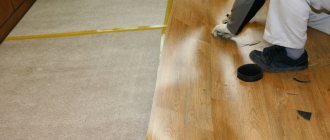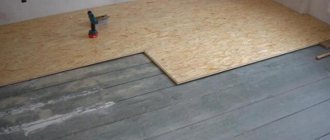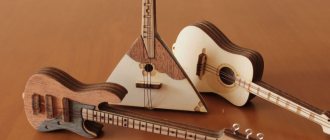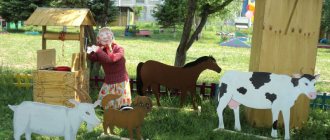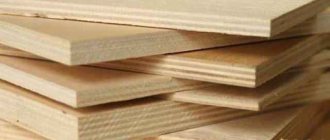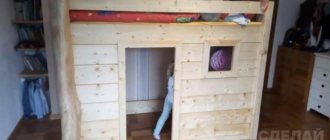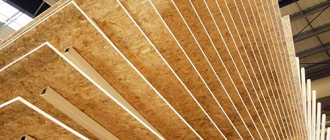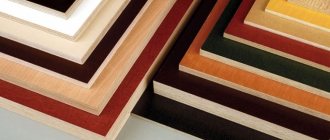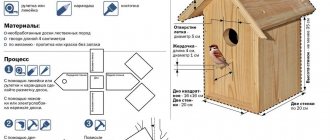How to choose?
When building a house, plywood is most often used, consisting of 3-5 layers of glued veneer. Veneer layers can be arranged in different ways in the sheet material; they are assessed based on the outer layers of the sheet. If the wood fibers are located in the direction of the length of the sheet, then such plywood is called longitudinal. If the fibers are located in the direction of the width of the sheet, then such plywood is considered to be transverse. Longitudinal sheet plywood is used where high flexibility of the sheet is required when performing work. Transverse plywood is used in cases where good rigidity is required, which occurs when this material bends.
Due to the impregnation of the layers with glue, plywood sheets are highly resistant to humidity and water. The most common are several brands.
FC - is a moisture-resistant sheet, the veneer inside of which is impregnated with glue consisting of a mixture of resin and formaldehyde. If plywood has an E1 impregnation class, it means that the degree of release of formaldehyde vapor into the external environment is low, and such material can be used in residential premises.
Finished sheets of pressed plywood are sanded.
There are two types of plywood products.
Sanded - if only one side of the sheet is sanded, then the code Ш1 is added to the nomenclature of the plywood grade. If both sides are sanded, then the product is marked with the code Ш2.
Plywood, sanded on both sides, is used for the production of furniture products. If you are choosing a material for construction work, then it makes no sense to overpay for sanded sheets - you can get by with a cheaper unsanded option.
Plywood sheets are divided into 5 grades. The best grade is marked with the letter E, which denotes elite and high quality products. Then, as they deteriorate, varieties are divided into I, II, III and IV. The grade is determined by the appearance and quality of the front sides of the material. Each side is evaluated separately, and the result in the nomenclature is written using a fraction sign. For example, plywood marked I/II will indicate that one side of this material corresponds to grade I, and the second side of the sheet has only grade II quality.
To correctly determine the amount of material needed for work, you need to make preliminary calculations before purchasing:
- determine the area of the plywood sheet;
- calculate the working surface area;
- divide the area of the working surface by the area of the plywood sheet, rounding the result up to whole numbers upward.
When purchasing material, you need to take a small supply, which will be needed in case of an unforeseen cut.
Experienced specialists recommend taking into account the following important nuances when purchasing plywood material:
determine the purpose of plywood and select the appropriate grade of material for this purpose, and also take into account the composition of the adhesive base; check with the seller what material the plywood sheets are made of - birch and pine wood are considered the most suitable for interior and exterior work; pay attention to the quality of the sheet surface - there should be no chips, bubbles or foreign inclusions on it.
For the manufacture of furniture products, plywood sheets are used, the thickness of which does not exceed 9-10 mm, while for construction purposes they take material with a thickness of at least 12 mm. Finishing work is carried out using sanded plywood of grade E or category I with mandatory sanding of the outer side. For other work, the appropriate class of material is also individually selected and the need for grinding is determined. The cost of a plywood sheet directly depends on its grade, size and thickness. The larger the dimensions of the sheet and its thickness, the more expensive the material is.
Which plywood is better, see below.
Grade and marking
Depending on the quality of the material, there are four main grades and grade E - elite, the properties of which are regulated by GOST 3916.1-96. The types of veneer on the front and back sides may differ, which helps reduce the cost of products.
| Material grades | Characteristics |
Grade E | The highest quality. The presence of visible processing defects or wood defects is not allowed. The surface of the sheet should have an even color and pattern |
| 1st grade | High quality veneer, no more than three defects per sheet are allowed: small knots up to 1.5 cm in diameter, closed cracks, brown veins, edge processing defects up to 2 mm wide. Inserts that differ in color or texture are also allowed, provided that their area does not exceed 2% of the sheet area |
2nd grade | No more than 6 defects per sheet are allowed: fused or unfused knots, small cracks, wormholes with a diameter of up to 6 mm, dark veins. Also on the surface there may be minor dents, leaked glue, inserts of a different shade with an area of up to 5% of the total area of plywood |
3rd grade | The number of defects is no more than 9 per sheet. These can be knots, wormholes up to 6 mm in diameter, inserts that differ in texture and color, cracks up to 2 mm wide, stains of leaked glue. Defects in edge processing and disruption of the fiber structure in certain areas are also acceptable. |
4th grade | Lowest quality material. Veneer may have a wavy surface, torn fibers, dents and cracks of varying lengths. There may be a large number of wormholes and small knots on the sheet, leaked glue |
The lower the grade of the material, the cheaper it is and the lower its performance properties, since the presence of cracks or wormholes reduces the bending strength of the sheet and its resistance to mechanical stress. The grade is indicated by two numbers that indicate the grades of the outer layers of veneer. For example, the numbers 1/2 in the marking of plywood mean that on one side of the sheet there is veneer of the first grade, on the other - of the second. The numbers 1/1 indicate that both sides of the sheet have first-grade veneer.
Plywood grade 1/2
Plywood grade 3/3
Plywood grade 3/4
Grade 3 plywood is quite suitable for laminate flooring: it is inexpensive, but at the same time quite strong and durable. If the screed serves as a rough base, and the traffic of the room is low, in order to save money, you can use fourth grade plywood. It is not practical to use grade 1 and 2 plywood as a subfloor due to its high cost.
Birch plywood grade 3/4
In addition to the type of plywood, you need to know other markings. According to GOST, sheets are marked with special paint on the reverse side. The marking must include the following designations:
- Name;
- brand;
- grade;
- emission class;
- type of material processing;
- sheet dimensions.
Of primary importance is the grade of material, which is based on the type of binder for the veneer sheets and determines the degree of water resistance of the plywood.
| Brand | Characteristics |
FC | Urea glue, which is relatively resistant to moisture, is used as a binder. The material has good strength, low content of toxic resins, and low cost. This type of plywood is widely used in construction for interior work. |
FSF | The binder is phenol-formaldehyde resins, thanks to which the material has excellent resistance to moisture and mechanical stress. Due to the presence of toxic components, plywood of this brand is not suitable for residential premises |
FB | Bakelite varnish is used for gluing veneer. Finished sheets have maximum resistance to water and other negative influences. It is characterized by high cost, which limits the use of plywood in construction |
| FBA | Albumocasein natural glues act as binders. Of all types of plywood, this is considered the most environmentally friendly, but it is not resistant to moisture. |
FKM | Melamine resin is used for gluing veneer. This binder provides high resistance to moisture and does not emit toxic compounds, so plywood of this grade can be used in residential premises |
Equally important is the emission class, which is designated by the letter “E” and the numbers 1, 2, 3 and indicates the content of formaldehyde resins in 100 g of material:
- E1 – less than 10 mg;
- E2 – from 10 to 30 mg;
- E3 – from 30 to 60 mg.
To avoid negative health consequences, E3 plywood should not be used in residential premises.
Formaldehyde in plywood
According to the type of surface treatment, the material is divided into polished and unpolished, and this is designated as follows:
- NSh – unsanded sheets;
- Ш1 – plywood sanded on one side;
- Ш2 – grinding on both sides.
The roughness that is present on the surface of unsanded sheets does not in any way affect the quality of laying the laminate, so there is no point in overpaying and buying sanded plywood. Moreover, it is inappropriate to use painted or laminated sheets, the cost of which is much higher than usual, but the performance properties are the same.
Sanded plywood
FC plywood, unsanded
As for plywood manufacturers, the most preferable are the products of domestic companies, which combine good quality with a very reasonable price. For European manufacturers, the cost is higher, but for Chinese companies, the quality of plywood often causes a lot of complaints, and the characteristics of the material in most cases do not correspond to the declared ones.
Types of plywood (wood species):
Birch - the main advantage is strength. Optimal where increased loads and pressure will be placed on the building material;
Coniferous – the main advantage is durability and light weight;
Combined – the main advantage is the price. Combined plywood is closer in quality to birch, but much cheaper.
Plywood is also divided according to its intended purpose:
- furniture;
- ship;
- construction;
- aviation;
- formwork;
- decorative;
- transport.
In principle, we have examined the main points by which plywood sheets are classified. Be sure to take into account the properties of the material depending on the varieties, brands, etc., in order not to make a mistake in your choice.
And you can buy plywood in Minsk in our Temple store. We offer high quality products at very affordable prices. You can place an order for plywood and get the necessary advice from our specialists by calling the numbers listed on the website.
Advantages of using plywood to level the surface
A plywood floor in a wooden house is natural and practical.
Using plywood as a leveling base is an excellent solution. It is worth noting the main advantages of this material:
- reasonable prices;
- easy operation and transportation;
- use on surfaces that are easy to prepare;
- the ability to level out strong differences and increase the service life of old wooden floors;
- strength and wear resistance;
- flexible structure, does not break under heavy loads;
- minimum joint area.
Thanks to all these qualities, plywood is used as a leveling base for plank floors.
What kind of plywood can I use?
In order to carry out a dry floor screed, it is necessary to lay structural or building type plywood as the main material. The brand of plywood should be selected depending on the conditions in which the material will be exposed.
There are 3 main types of plywood.
- FSF is birch plywood, which consists of veneer and has resin and formaldehyde components in its adhesive composition. The material has high performance qualities and is resistant to moisture. Can be used for both internal and external types of work.
- FK - veneer sheets in this plywood are connected with glue, which contains formaldehyde. The material is resistant to wet environments, but can only be used for interior work.
- FBA - the adhesive composition of this plywood does not contain formaldehyde components and consists of casein, which is harmless to humans. This material has reduced resistance to moisture and can only be used indoors in dry rooms.
Based on the quality of production, plywood is divided into 5 grades. Grade E is elite, while low-quality materials are grade IV.
The size of the material also plays an important role in choosing the material. If you plan to make flooring from small fragments of plywood, then use material 1525x1525 mm
It is convenient to work with, but on large surfaces you will have to make a lot of joints. Dimensions 1210x2440 mm are more convenient. A sheet with such parameters is used in typical city apartments for flooring in rectangular rooms.
Having decided on the dimensions of the sheet, you need to choose the right thickness of the material. In this case, you will need to take into account all the nuances of the screed device.
The calculation of the thickness of plywood for the flooring is selected depending on the step with which the logs are laid:
- if the distance between the logs is from 35 to 40 mm, then the thickness of the plywood sheet should be at least 9-10 mm;
- if the sheathing has cells with a side of 50 cm, then the flooring is made of plywood 10-12 mm thick;
- if the step between the sheathing segments is 60 cm, then the flooring is made of 12-14 mm plywood.
When choosing the thickness of plywood, it is necessary to provide an additional safety margin in terms of thickness for the weight load to which the floor surface will be subjected. To arrange massive furniture, it is best to take plywood, the thickness of which is 16-18 mm.
When the dimensions and thickness of the sheet are determined, you need to calculate how many sheets you will need to buy to complete the floor screed. You can calculate material consumption as follows:
- Having clearly measured the dimensions of the room, draw a diagram of the location of the logs on paper, determining their number and pitch;
- the diagram shows how the plywood sheets will be arranged, taking into account the format of the material;
- Based on the final data, the required amount of material is calculated.
In cases where the shape of the room has a complex configuration, the object is divided into parts and each of them is considered separately. If the room has the correct proportions in the form of a square or rectangle, then calculate the floor area and count the number of sheets needed to cover it, taking into account the area of the plywood sheet.
Pros and cons of using plywood for flooring
Plywood covering has a whole list of technical advantages compared to other types of building materials:
- the material has minimum humidity levels - up to 15%;
- when excessive mechanical stress occurs, plywood absorbs most of it, preventing damage to the concrete floor;
- During production, natural veneer is used without adding harmful impurities that are present in chipboard and OSB boards. It is worth noting that more and more often people are laying OSB on the floor, since this material has proven itself well;
- the material acts as thermal insulation from rough floors;
- unlike pouring a cement screed, laying wood slabs on joists is a less labor-intensive process;
- plywood has high resistance to bending, so it can withstand very heavy loads;
- There are several brands and grades of plywood, which makes it suitable for use as rough and fine flooring.
Among the disadvantages of laying material on logs, the following points can be highlighted:
- poor resistance to large temperature changes;
- the material is afraid of moisture, so it is advisable to use it in dry rooms.
Plywood: sheet dimensions, thickness
For different jobs, sheet material of different sizes may be more convenient. And plywood is no exception. It is available in different sizes, which are usually divided into standard and non-standard. Standard ones are prescribed in GOST standards (GOST 3916.1-96), non-standard ones are produced to order - for large companies or those formats that are more in demand in retail. Usually a sheet of plywood has the shape of a rectangle, but it can also be in the shape of a square.
There are rectangular and square plywood sheets
Standard plywood sizes
In general, different types of plywood are described by different GOSTs (GOST 2707, GOST 20907, GOST 102-75, GOST 3916.1-96) and they contain different size grids.
Standard sizes may vary depending on regulations
The most popular small-format plywood sheets have the following standard sizes:
- 1220*1220 mm;
- 1525*1220 mm;
- 1525*1525 mm.
Small sheets of plywood are good because you can work with them without helpers. But a large number of seams is not good.
According to GOST 3916.1-96, it is allowed to produce plywood of non-standard length by agreement between the manufacturer and the consumer.
Plywood dimensions according to GOST 3916.1-96
In theory, combinations from the above list can be any. In practice there are much fewer of them.
Large format
In some cases, it is more convenient to use large sheets of plywood - there are significantly fewer joints. The most commonly used large format plywood is the following sizes:
- 1830*1525 mm;
- 3050*1525 mm
- 3000*1500 mm;
- 2500*1250 mm;
- 2440*1220 mm.
Plywood: dimensions and thickness are standardized by a large number of standards
No one has brought order to the standards, so theoretically you can find almost any size that fits into one of them. So, for example, according to GOST 102-75:
- The length of the plywood sheet can be from 1000 mm to 1525 mm. The length change step is 25 mm.
- The width can be from 800 mm to 1525 mm with the same gradation pitch - 25 mm.
Moreover, the maximum deviation in length and width is 4 mm. The thickness of the plywood can be from 1 mm, but this is a rare “aviation” grade. The usual one is available in thicknesses from 3 mm to 30 mm, but you can find up to 40 mm. The permissible error in thickness dimensions is 0.5 mm.
There are standards regulating the sizes of coniferous and hardwood plywood
If you look at the later standard 3916.1-96, it specifies a different grid of plywood sizes with a specific listing of possible values (see table above).
Thickness
The picture with the thickness of plywood is approximately the same: if desired, you can find from 1 mm to 40 mm thick. It is possible that there are thicker options. But most often there are slabs with a thickness from 6 mm to 27 mm.
Thickness of hardwood and softwood plywood, ply layers and permissible deviations for sanded and unsanded boards
By the way, it’s interesting that any of the standards states the maximum permissible deviation is 0.5 mm
Which, considering the number is not always large, is not so little. And this deviation can significantly complicate the installation of the material on the floor.
The difference has to be corrected with thin pads, or, if it is small, sanded off at the joints with a sanding machine.
Material characteristics
The strength and durability of the plywood substrate directly depends on the thickness of the sheets, strength indicators, number of layers and type of processing. Therefore, when choosing plywood, you should pay special attention not to the appearance, but to the technical characteristics of the material.
Plywood thickness
The choice of plywood thickness depends on the type of rough base and the method of laying the sheets. If you plan to lay plywood on a concrete screed, a thickness of 15 mm is sufficient; for a plank floor it is better to take a little more - 18 mm. In both cases, the sheets are laid in one layer. When installing on joists, it is recommended to attach plywood in two layers to avoid sagging of the material and to give the base maximum rigidity. Here you can take sheets 15 mm thick or make the bottom layer thicker, for example, 21 mm, and the top layer thinner (12-15 mm). The wider the distance between the joists, the thicker the flooring should be.
Table of characteristics of the main brands of plywood
The thickness of plywood is determined by the number of layers of veneer it consists of. The thickness of each layer varies within 1-1.5 mm, so different manufacturers of plywood of the same thickness may differ in the number of layers and vice versa. It should be noted that sheets with the maximum number of layers have the greatest rigidity, and not thicker ones.
Sheet sizes
Based on size, plywood is divided into format and large format. The first type includes sheets with maximum dimensions of 1525x1525 mm, the second - from 1830x1525 to 3000x1500 mm. It is more convenient to work with smaller plywood, but at the same time, a large number of joints reduces the rigidity of the coating. When choosing the size of sheets, you must take into account the size and configuration of the room so that you have to trim the material as little as possible.
Plywood. The layers are clearly visible at the ends
Material of manufacture
Based on the material used, plywood can be birch or coniferous. This means that in the first type the upper layers are made of birch veneer, in the second - from pine, spruce or larch veneer, as well as other conifers. The inner layers are usually made from cheap wood, both hardwood and softwood. Visually distinguishing the material is quite simple: birch plywood is lighter and has a weakly expressed texture, while coniferous plywood has a richer color and a beautiful pattern on the surface.
Birch plywood
The bending strength of birch plywood is 10-12% higher, so it is used where the floor is subject to increased loads. It is denser and heavier than coniferous, which is not always convenient during installation, and is also more expensive. Coniferous plywood is more practical: it is cheaper, lighter in weight and resistant to rot, fungi, and mold. This type is more suitable for installing a subfloor in a residential building, because there are no intense loads on the base, and moisture is often high.
Softwood plywood
Combined plywood is also produced, the structure of which includes both birch and coniferous veneer. This material combines good quality, strength, attractive texture and affordable cost, and it is most often used in furniture production and interior decoration.
What does combined plywood look like?
Prices for plywood for flooring
plywood for floor
What it is?
The name USB cannot be considered official - rather, it is a distorted version of OSB, which is how oriented strand board is labeled. USB plywood is sometimes called its universal variety, but the characteristics of the material are no different from the regular version. OSB is produced in the form of large-format sheets or, as they are also called, boards. This type of plywood does not have a solid structure, but consists of wood chips joined together in layers using glue based on natural or synthetic resins.
USB sheets are characterized by high density and strength. Usually the slab consists of 3-4 layers, in each of which thin chips are glued together and with the previous layer. For the connection, resins mixed with boric acid and synthetic wax are used. These materials are called oriented because their layers have a multidirectional structure: the outer layers are directed longitudinally, the inner layers are directed transversely.
USB sheets have certain characteristics.
- High moisture resistance. Material completely submerged under water will increase in volume by no more than 10% after 24 hours.
- Resistance to biological damage. Neither insects, nor mold or mildew are harmful to the stove.
- Improved fastener retention rate. Compared to particle board and softwood plywood, the superiority is about 25%.
- High quality. The selected raw material contains no knots or voids, and the likelihood of delamination is minimal.
This is the basic information you need to know about the material known as USB board. In addition, it is inexpensive, visually looks quite attractive even without coating, and is stable in its composition and chemical properties.
How to use plywood
Initially, it may seem that plywood sheets are fragile and cheap. But practice shows that this material is many times superior to MDF, chipboard, OSB, fiberboard and other recyclable materials. And you don’t need to ask yourself the difficult question of how to choose a parquet board. The main advantage of plywood lies in the specifics of its production. There is no gluing of the residual mass of wood and a liquid binding substance. Each plywood sheet consists of several layers of working wood. And due to the fact that these layers have multidirectional fibers, the floor is strong and reliable. You can read about what tongue-and-groove moisture-resistant chipboard for flooring is in the article.
You can find out how much 1 sheet of moisture-resistant plywood costs from this article.
Laying a plywood floor aims to achieve three main goals.
- “Smoothing” uneven surfaces and preparing for final coating.
- Ensuring the required level of thermal insulation.
- Protection of parquet boards from moisture.
Of course, there is also plywood for finishing the floor. But we will not consider this option due to its specificity and low prevalence. The plywood is placed either directly on the floor, or raised above it with the help of logs - special beacon bars.
What are the technical characteristics of moisture-resistant plywood can be found in this article.
The video shows the thickness of the plywood on the floor:
Along the sheathing
There are many ways to level plywood floors. When sheets are used in work, logs are most often installed, and elements are fixed to them. But here, too, there are two main ways to get rid of surface defects on a concrete floor:
- Installation of strip supports.
- Point supports.
In each case, there is a sequence of work that will contribute to obtaining an ideal, even floor.
Belt supports cannot do without transverse and longitudinal components. Regarding the longitudinal ones, we can say that they should not fit tightly to the walls. A distance of approximately 30 mm must be maintained, which is necessary for deformation movements. The sheets used to level the floor under the plywood affect the distance between the joists. Usually the distance is selected within 40-50 cm.
For this method there is a sequence of actions, which include:
- Initially, plywood is laid out on the floor surface. In this case, you do not need to attach it, but simply try it on, determining the required number of sheets. The staggered arrangement of sheets of material must be observed.
- The installation locations of the longitudinal elements of the sheathing are drawn from the sheets.
- It would be a good idea to number each sheet of plywood so that there are no problems with installation in the future.
- The floor joists are laid out according to the marks. To begin with, they are fixed near the walls, and then between them. Even cut plywood can be used as a material.
- To level the floors, the sheets are screwed to the joists using self-tapping screws. You can additionally use metal corners.
- According to building codes and regulations, wooden blocks or metal wedges should not be placed under the joists if it is necessary to raise the level. The best option here is to add sand, or lay down roofing felt.
- To improve the quality of leveling the floor with plywood, all voids between the joists should be filled with thermal insulation material. An alternative is sawdust mixed with PVA glue.
When there are significant differences in height in the room, you can use the technology of leveling the concrete floor with plywood mini-joists. But few people can cope with such a task on their own. To do this, it is better to invite specialists who can do everything efficiently.
Now let's get back to using point supports. This option involves the use of OSB boards, wood or plywood elements as supports around the perimeter of the room. Their height should correspond to the difference in plywood thickness and level difference on the base. Since the reliability of such a design is much less, the number of supports should be increased.
We must not forget about underground ventilation. After installation, holes are drilled at pre-marked points on the plywood sheets. They are perfectly hidden by decorative elements (ventilation grille).
What does the thickness of plywood affect?
Any builder is interested in how thick plywood is needed for a particular construction task.
Regardless of the manufacturer and type of plywood, its standard thickness range is between 3-30 mm . Therefore, home-grown builders often do not know what thickness of plywood for the floor they need in their particular case. But this characteristic is the most important, since during operation a large load falls on the wooden floor.
Other characteristics depend on the thickness of the plywood:
- Leveling degree. The thinnest plywood is the worst at leveling the surface, especially for flooring on boards that have a large number of defects.
- Possibility of insulation. Since wood is a poor conductor of heat and sound, plywood can partially or completely replace additional sound insulation and thermal insulation.
- The degree of rigidity also depends on how thick the plywood is laid on a wooden floor, because the greater the thickness, the more perpendicular layers of veneer, the harder the surface becomes, but at the same time elasticity is maintained.
However, the thickness of the room has virtually no effect on the height of the room, so whatever thickness of plywood you choose for the floor, it can reduce the height of the room by a maximum of 4 cm.
Installation work
After cutting the plywood into sections, they will need to be laid out on the floor surface to adjust to the area of work
It is extremely important to take into account the gaps (between the sheets inside - up to 10 mm, between the sheet and the wall - up to 20 mm)
Screed flooring is carried out on both wooden and concrete floors. The flooring should be slightly offset to avoid grouping all four seams in one place.
After preparing the plywood sheets for the floor, each one is numbered - installation will be faster and more convenient.
For better installation, a plywood sheet 1.25 m X 1.25 m should be cut into pieces of 0.60 m. If, when cutting the sheets, a large number of delaminations are observed - the first sign of poor-quality material, the floor should not be laid with such plywood.
Working with rough coating
One of the fastest and most effective types of work with plywood. Has several types of styling:
On a concrete type screed.
Plywood up to 12 mm thick must be glued onto the screed. The flooring is smooth. Expansion joints - 4 mm between sheets, 3 mm - between the wall and the plywood sheet.
Installation of plywood on a screed
If there is a difference in level in the room, special fasteners will be required, which will be located under the sheet. Such floors do not require logs.
Fastenings that allow you to adjust the level of the flooring
Laying on joists
Before the flooring, a base of logs is installed. The sheet thickness must be more than 12 mm. Working with this type of installation is difficult, time-consuming, and durable. Required for insulation and raising the floor to the required height. The correct placement of logs and plywood sheets will allow you to cover differences in the height of the room.
Laying flooring on joists
Leveling the floor with plywood
In 90% of cases, floors made from a wooden base lose their appearance over the many years of their existence, but do not lose their evenness and do not require tearing off the floor. There is a solution in this case - laying a covering on top of the wooden floor.
In order not to worsen the condition of the finished floor, plywood sheets (intermediate covering) are laid on top of the wooden covering, which is used to level the floor for subsequent finishing work.
Leveling the floor with plywood sheets
Laying plywood on a wooden floor using self-tapping screws is simple, cheap, quick, and without much effort or investment.
If the finished floor is not made of wood, then you should adhere to the rules of overlay:
- When cutting the material, during installation, each one should be numbered, and the laying should be done with a shift.
- During installation, the sheets must be firmly fixed and not “walk” on the floor.
- Deformation gaps should be taken into account.
- It is good to “drive” the screw heads into the plywood so that the surface is smooth.
- Fill the identified depressions with putty.
- Use a backing.
Plywood finished floor
Wide-ranging specialists can create an indescribable beauty of finished flooring from plywood. To do this, only first grade plywood is taken for the floor, and the surface is sanded to perfect condition.
If desired, for a better appearance of the coating, it is covered with varnish, stain, and all kinds of patterns and designs.
Here are some installation options for your finished floor
Decorative plywood floor
Laying plywood on a wooden floor
Repairing an old wooden floor is not easy at all. It's easier to lay plywood on top. Before this, it is necessary to carry out an inspection, eliminate the creaking, and install, if necessary, additional fasteners. If there are large differences in height, it is better to eliminate them too. Cut off the humps, fill the cracks and sand them. There is no point in achieving perfect smoothness, but large differences can also cause problems in the future. How to repair differences in a wooden floor before laying plywood? There are several options:
- Use a mixture of wood chips and varnish or paint. Fill the depressions and cracks with this mixture and level it out. After drying, use sanding to bring it level with the surface. This method is good if there are depressions.
- If the boards are bent over, a different technology is needed. We need to cut off our humps. Planing paint is long and difficult. In this case, it is better to remove the old paint with a blowtorch, and then level out the differences using: a sanding machine (rent);
- electric plane;
- belt sanding machine.
You can attach plywood to a wooden floor using nails or self-tapping screws.
They also use wood mastic or wood glue. Plywood can already be laid on a relatively level floor. But in the case of a wooden floor, it is necessary to use two layers, because the first layer has some unevenness. They are several times smaller than those of wood, but they still exist. The second layer of plywood is laid with overlapping seams so that the seams of the second layer do not coincide with the joints of the first. Then the second layer is leveling. It will be almost perfectly smooth.
Laying plywood on a wooden floor under linoleum, laminate - a requirement of flooring manufacturers
When choosing materials, keep in mind that plywood thickness may have certain deviations. For the second layer, choose sheets that differ minimally in thickness. Moreover, to level out differences in the first layer, you can use linings - thin strips of fiberboard of different thicknesses, strips of plywood, etc.
Before work, be sure to remove all construction debris and dust. It is a good idea to vacuum your wooden floor. Debris can cause squeaking. So don't ignore this step.
Laying technology
Before you begin laying the lathing for the flooring, you need to prepare the concrete floor for further work. The correct sequence of work is to first clear the floor of debris, and then inspect the surface for minor defects - chips, cracks, dents. All these shortcomings must be eliminated before the sheathing is completed.
In some cases, depending on the purpose of the room, before the frame structure is made and the floor can be covered with plywood, the concrete surface is waterproofed. These works can be done with your own hands. It is necessary to insulate not only the floor surface, but also part of the wall, up to the level of the finished floor.
Preparation
Having prepared the surface for laying lags, do not forget about possible unevenness of the walls. An uneven wall will not allow you to lay an even sheet of plywood. There are two ways out of the situation: either level the walls before starting the floor repair, or cut the plywood sheets based on the curvature of the wall.
Trimming is done as follows:
- a sheet of plywood is moved in a lying position to the wall so that its opposite edge is placed strictly parallel to the joist on the floor;
- a separate rail is placed parallel to the wall on top of the sheet;
- draw a line along which they cut the plywood sheet.
Before starting flooring work, you need to prepare the material. It is cut into the required length and width elements in accordance with a previously drawn up schematic work plan.
Frame formation
The next stage of work, when the wooden blocks are cut to size, is the sheathing itself. The sheathing structure should not be made close to the wall; there should be a distance of 10-15 mm between them.
Log installation sequence:
- select the point that protrudes the most above the floor level; all other logs will be aligned along it;
- to speed up the installation process, you need to stretch the cord along the sides of the room, checking its position using a building level;
- a backing made of a piece of thin plywood is laid under each joist; it increases the contact area of the support;
- the logs are secured to the concrete base with anchor hardware;
- the spacing of the wooden blocks must correspond to your schematic plan, a range from 35 to 60 cm is allowed;
- The beams are fastened together with screws and metal jumpers.
When performing the sheathing design according to the drawing, you should end up with an even horizontal structure. The logs are placed with a uniform spacing and distance from the walls. The gap between the wall and the sheathing is made so that, under the influence of moisture, the expanded wood does not lift the plywood flooring and cause deformation of the laminate or other floor covering.
Floor insulation
To insulate the floor, mineral wool or polystyrene foam is used, which is placed in cells formed by the intersection of the joists in the sheathing. Before installation, mineral materials should be given 24 hours to adapt to the conditions of your room, so that after installation no gaps or voids are formed. Sheets of foam plastic or insulation are cut so that they fit tightly into the sheathing cell. The top part of the insulation should not reach the edge of the joists by 1 cm.
Fastening sheets
Prepared and cut plywood sheets are laid on the sheathing as follows:
- the installation begins from the far corner of the room and moves along the direction of the solid wall;
- the distance from the wall to the plywood sheet should remain 10 mm;
- Attachment points are marked on plywood sheets, retreating from the edge of the sheet by 2 cm;
- the interval between screws is 20-30 cm;
- The heads of the screws must be completely recessed into the plywood material; to do this, before installing them, a hole is made in the sheet using a wood drill with a countersink.
- after installing the 1st row, the surface is cleared of chips and the 2nd row is laid out;
- When fixing a sheet of plywood, you need to start working from the center to the periphery - this makes it possible to place the sheet more evenly on the sheathing structure;
- When laying plywood in 2 layers, the seams of the joints are broken in a checkerboard pattern.
After the flooring is completed, you need to sand the floor surface with a grinding machine. For this purpose, choose a nozzle with an abrasive of 120 units. After sanding is completed, the floor is cleaned of shavings and dust, and then the joint seams and screw holes are filled with sealant. Instead of sealant, you can use wood putty. When the material hardens, the seams are treated with sandpaper. After completing these works, you can begin laying linoleum, tiles or laminate.
Leveling the floor with plywood
This process is carried out by installing wooden logs on a concrete base. Coniferous logs are used, installation pitch is approximately 600 mm.
With a relatively flat base, plywood is laid on concrete, first smoothing out its unevenness.
Sometimes, if there is a strong and level surface of the old floor, plywood is simply laid down and secured on top.
In any of these options, it is advisable to use low-grade material; this is much more profitable than using high-quality varieties.
Thickness and purpose of plywood
The thickness of the plywood sheet depends on the number of layers of veneer. Each of them can be from 1 mm (hulled) to 3.5-4.0 (planed). Rotary cut veneer material is more flexible. In terms of strength characteristics, planed is better.
Production of planed and peeled veneer
The layers are connected with glue under pressure, so that the direction of the wood fibers in them does not coincide - this significantly improves the ability of the material to withstand mechanical damage. The composition of the adhesive determines the level of moisture resistance and safety of plywood:
- FSF (glued with phenol-formaldehyde resins) - used only for non-residential premises and outdoor work, high moisture resistance (thickness 4-40);
- FKM (use melamine resins) – average water resistance and safety;
- FC (formaldehyde and urea-formaldehyde resins) – used exclusively for interior work, does not withstand moisture (thickness 3-24);
- FBA (glued with albumin casein glue) is an environmentally friendly material, non-moisture resistant (sheets with a thickness of 3-8 are produced);
- FB (or bakelite plywood) - withstands any environmental influences, including high humidity, open fire, mechanical damage (available in thicknesses 7-40), used in shipbuilding, automobile production, construction of podiums, stadiums.
Bakelized (bakelite) plywood
Thickness 3mm
Plywood with a thickness of 3 mm or less is called aircraft grade. Previously, it was used in the aircraft industry, but now it is used mainly in modeling. The material bends easily, so unusual interior items are made from it. Available in two sizes 1525x1525 and 1525x1830. Packaged in packs of 130 pcs. Total weight 590 and 707 kg respectively.
Thickness 4 mm
The scope of use of such a sheet is already wider. It is suitable for the production of furniture, wall decoration and even flooring. As a rule, it consists of 3 layers of veneer. The most popular size is 1525x1525.
Thickness 6.0, 6.5 mm
Five-layer sheets for construction and furniture assembly. The thickness allows you to produce fragments up to 3 meters long. The most common sizes: 1525x1525, 1220x2440, 1500x3000.
Plywood 8, 9,10 mm
Sheet of 7 layers of veneer. It is used for both finishing and furniture production. The material will withstand the load as a floor when laid in one layer. Available sizes: square 1525x1525, rectangle 3000x1500, 1220x2440.
Plates 12, 15 mm
Sheets of plywood whose thickness exceeds 12 are called slabs. They consist of 9 or more layers of wood. They are used for the construction of structures that require heavy loads: shelving, partitions, floors.
Plates 18 - 30 mm
To produce these boards, 15 or more layers of peeled veneer are glued together. When using planed, their quantity is approximately 2 times less. This plywood is very durable and is used for interfloor slabs, decking, formwork for foundations, and the construction of summer kitchens.
Types of plywood
Types of plywood are determined by the scope of its purpose:
- construction;
- furniture;
- structural;
- industrial;
- packaging
Types of plywood depend on the glue used in production:
- FC – waterproof plywood. Kabamide glue is used in its manufacture;
- FSF – plywood with increased moisture resistance. Here the veneer sheets are glued together using phenol-formaldehyde glue;
- FBA is a non-waterproof plywood. In this case, albumin casein glue was used to glue the veneer. FBA plywood has little moisture resistance, but is highly valued by those who prioritize the environmental friendliness of the material;
- FB is a plywood that, thanks to the use of bakelite varnish, can be used in particularly damp conditions and in water.
And these are just the main types of plywood. There are many more stages of classification, depending on the thickness of the sheet, the number of layers, type of wood, grade, degree of finishing and type of additional processing.

